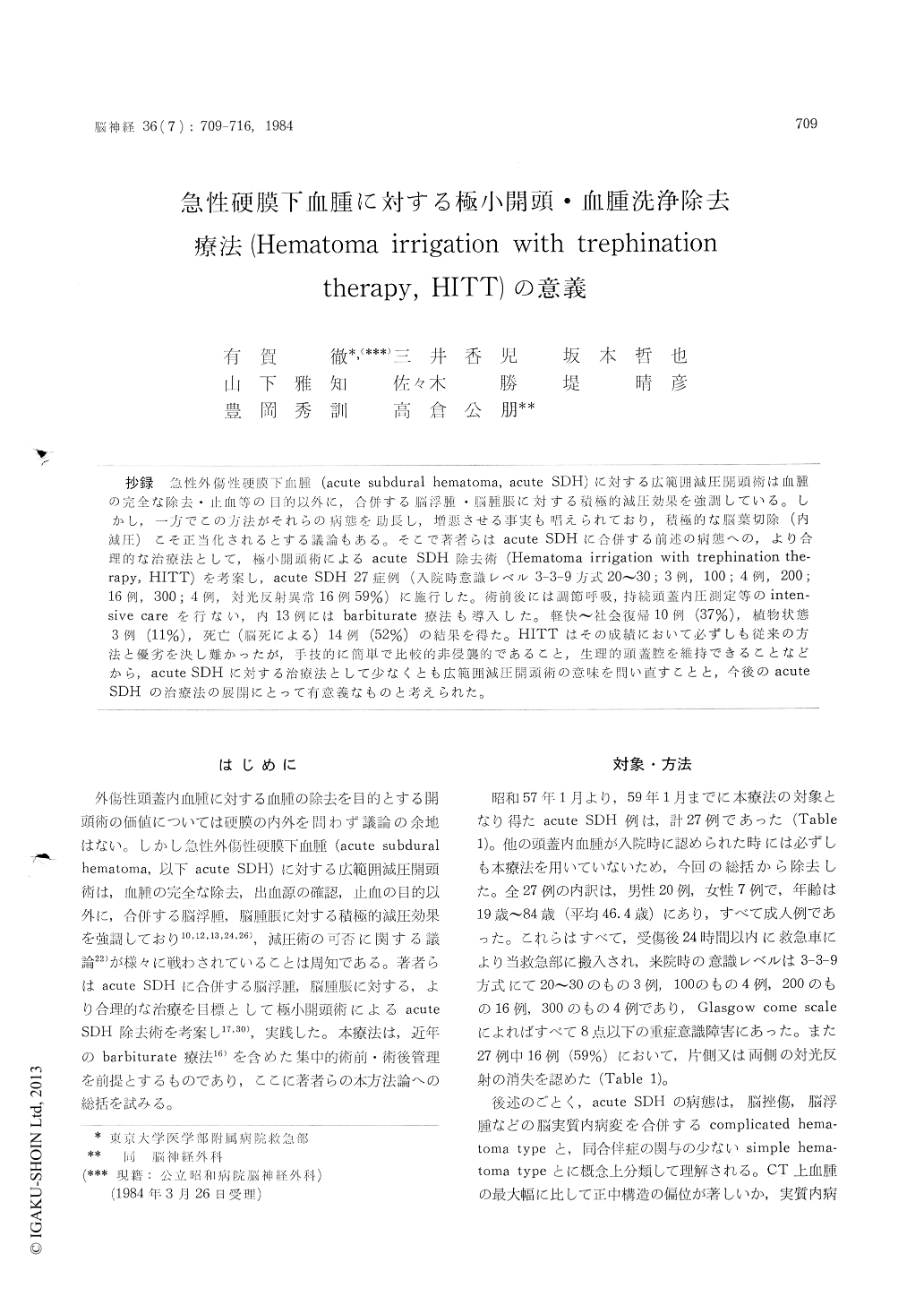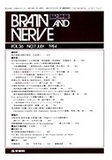Japanese
English
- 有料閲覧
- Abstract 文献概要
- 1ページ目 Look Inside
抄録 急性外傷性硬膜下血腫(acute subdural hematoma,acute SDH)に対する広範囲減圧開頭術は血腫の完全な除去・止血等の目的以外に,合併する脳浮腫・脳腫に対する積極的減圧効果を強調している。しかし,一方でこの方法がそれらの病態を助長し,増悪させる事実も唱えられており,積極的な脳葉切除(内減圧)こそ正当化されるとする議論もある。そこで著者らはacute SDHに合併する前述の病態への,より合理的な治療法として,極小開頭術によるacute SDH除去術(Hematoma irrigation with trephination the—rapy,HITT)を考案し,acute SDH 27症例(入院時意識レベル3-3−9方式20〜30;3例,100;4例,200;16例,300;4例,対光反射異常16例59%)に施行した。術前後には調節呼吸,持続頭蓋内圧測定等のinten—sive careを行ない,内13例にはbarbiturate療法も導入した。軽快〜社会復帰10例(37%),植物状態3例(11%),死亡(脳死による)14例(52%)の結果を得た。HITTはその成績において必ずしも従来の方法と優劣を決し難かったが,手技的に簡単で比較的非侵襲的であること,生理的頭蓋腔を維持できることなどから,acute SDHに対する治療法として少なくとも広範囲誠圧開頭術の意味を問い直すことと,今後のacute SDHの治療法の展開にとって有意義なものと考えられた。
Decompressive craniectomy in the management of acute traumatic subdural hematoma (acute SDH) has been advocated as a treatment for the cerebral edema or swelling associated with it. The bony decompression with dural grafting seems successful in some patients, but surely enhances cerebral swelling and exacerbates edema in others. Whether the external or internal decompression could be justified is therefore a subject of controversy for the surgical treatment of choice. The authors, herein, proposed the new method with small cra-niectomy, 3 cm in diameter and irrigation with Nelaton's catheter for acute SDH with cerebral edema or swelling, that is the hematoma irrigation with trephination therapy (HITT) and performed it in 27 adult cases, 19 to 84 years of age (20 males and 7 females), who were transported within 24 hours after trauma and hospitalized in Depart-ment of Emergency Medicine, University of To-kyo Hospital during the period from January, 1982 to January, 1984, whose Glasgow coma scale points were 3 to 8 on admission, 16 cases (59%) of whom showed unilatral or bilateral absence of light re-flex. The patients were all placed under the intensive care, using artificial ventilation (27 cases, 100%), hemodynamic management with Swan-Ganz catheter insertion (10 cases, 37%), continuous in-tracranial pressure monitoring (27 cases, 100%) and barbiturate therapy (13 cases, 48%).
Ten cases (37%) recovered, 3 (11%) fell in vege-tative state, 2 of whom died of medical complica-tions afterwards and 14 (52%) could not avoid progressive deterioration to result in brain death. HITT, being easier and less invasive operative procedure for acute SDH, resulted in the overall mortality rate of 59%, which proved not neces-sarily superior or inferior to the conventional methods to manage acute SDH with brain edema or swelling and yet undoubtedly was sufficient to re-examine how large decompressive operations should be appreciated.

Copyright © 1984, Igaku-Shoin Ltd. All rights reserved.


